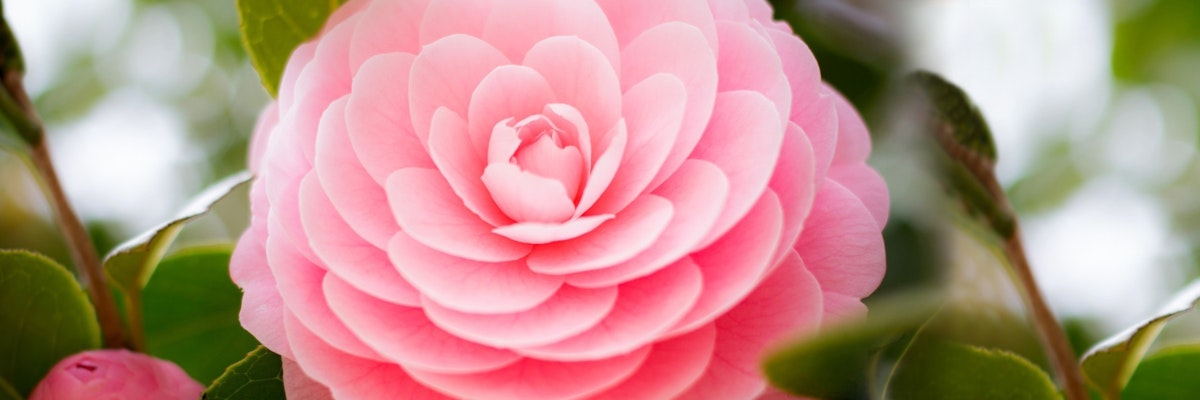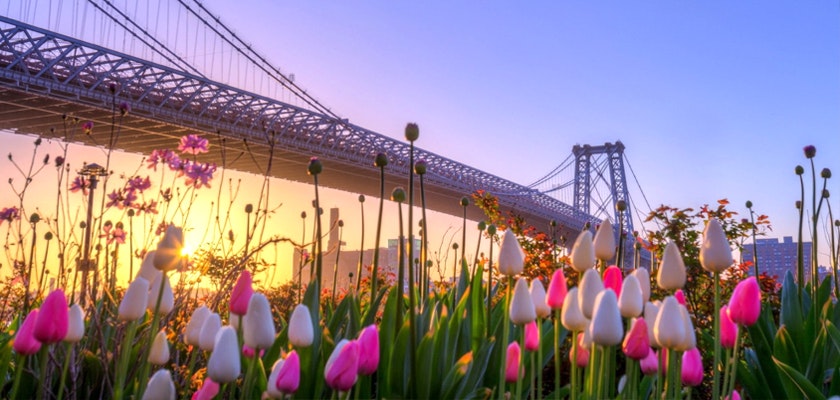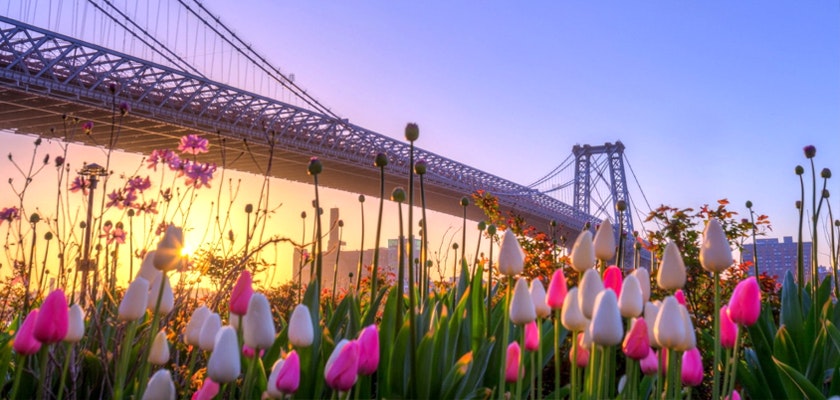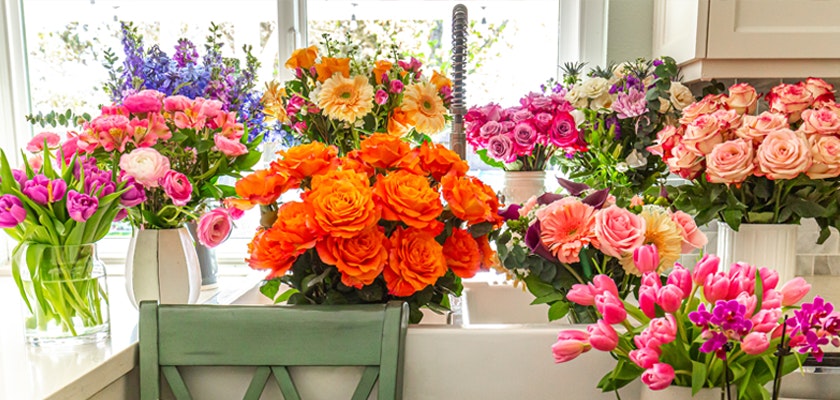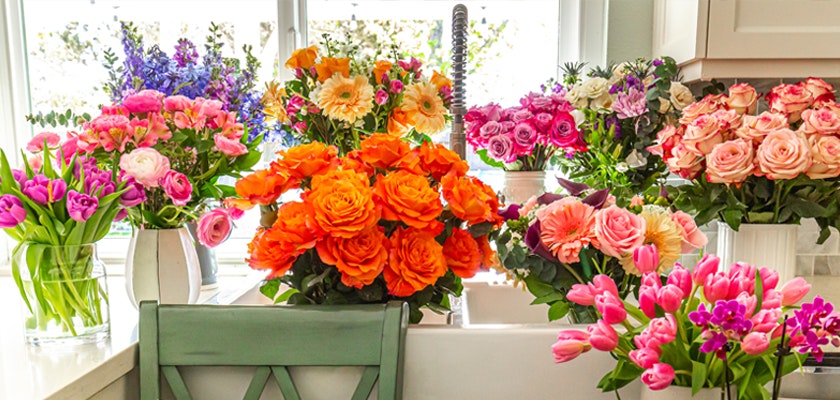Blossoms of Pride: A Comprehensive Guide to the Official U.S. State Flowers
The United States is a country of rich diversity, not only in terms of its people and cultures but also its flora.
Illustrated Guide to History & Facts
Every state in the union has an official flower that represents its unique identity and heritage. These state flowers, chosen through legislative actions, public polls, or historical associations, have become symbols of state pride and cultural significance.
This blog post takes you on a journey across the 50 states, exploring the history, facts, and beauty of each official state flower. From the apple blossom of Arkansas to the bluebonnet of Texas, these floral emblems tell fascinating stories about the states they represent. They're more than just pretty blooms; they're botanical badges of honor, embodiments of the spirit, and character of each state.
Whether you're a flower enthusiast, a gardening aficionado, or someone with a love for nature and history, this guide to U.S. state flowers promises a delightful and enlightening read. So let's embark on this floral journey, exploring the blossoming beauty of America, one state at a time.
Illustrated Guide to History & Facts
Every state in the union has an official flower that represents its unique identity and heritage. These state flowers, chosen through legislative actions, public polls, or historical associations, have become symbols of state pride and cultural significance.
This blog post takes you on a journey across the 50 states, exploring the history, facts, and beauty of each official state flower. From the apple blossom of Arkansas to the bluebonnet of Texas, these floral emblems tell fascinating stories about the states they represent. They're more than just pretty blooms; they're botanical badges of honor, embodiments of the spirit, and character of each state.
Whether you're a flower enthusiast, a gardening aficionado, or someone with a love for nature and history, this guide to U.S. state flowers promises a delightful and enlightening read. So let's embark on this floral journey, exploring the blossoming beauty of America, one state at a time.
The First State Flower and Its Legacy
The tradition of adopting state flowers was pioneered by Washington in 1892. The coastal rhododendron, known for its vibrant pink and purple blossoms, was chosen as the state's floral emblem through a vote involving 15,000 women. This democratic process marked the beginning of a nationwide trend, inspiring other states to select their official flowers.
The choice of the coastal rhododendron was not merely based on its aesthetic appeal. This hardy shrub, native to the Pacific Northwest, is known for its resilience and ability to thrive in diverse conditions, symbolizing the pioneering spirit and enduring strength of Washington's residents.
Over a century later, the legacy of this first state flower lives on. Each year, the rhododendron blooms serve as a vibrant reminder of Washington's rich history and the democratic values it cherishes.
Dual Blooms: States with Two Official Flowers
While most states have one official flower, a few states have designated two – a state flower and a state wildflower. This dual designation often reflects the state's diverse flora and the desire to recognize both cultivated and native species.For instance, Colorado has the cultivated Rocky Mountain Columbine as its state flower and the native Colorado Blue Columbine as its state wildflower. Similarly, New York recognizes both the cultivated Rose and the native Wild Rose.
This dual recognition not only celebrates the state's floral diversity but also encourages the preservation of native species and ecosystems.
Cultivating State Flowers in Your Garden
Adding state flowers to your garden can be a wonderful way to celebrate your state's heritage and enhance the natural beauty of your outdoor space. These native blooms often thrive in local conditions, requiring less maintenance than non-native species.
When choosing state flowers for your garden, consider their growing requirements such as sunlight, soil type, and watering needs. Some state flowers, like the sun-loving California Poppy or the shade-tolerant Pacific Rhododendron of Washington, may have specific needs that should be taken into account.
Also, consider the flowering season of your chosen state flower. With careful planning, you can create a garden that offers a succession of blooms throughout the year, providing a continuous display of color and beauty.
State flowers can also attract local wildlife, including birds, bees, and butterflies, enhancing the biodiversity of your garden. For instance, the Purple Violet, Illinois's state flower, is a favorite nectar source for butterflies, while Texas's Bluebonnet provides shelter and food for several bird species.
Finally, remember that gardening with state flowers is not just about aesthetics; it's a way to connect with your state's natural heritage and contribute to the conservation of local flora. So whether you're creating a patriotic garden or simply adding a touch of local color to your yard, state flowers offer beauty, symbolism, and a sense of pride.
The United States in Bloom: A List of State Flowers
Let's take a floral tour across the United States, exploring each state's official flower, the year it was adopted, and an interesting fact:
1. Alabama: Camellia (1959) - The Camellia was chosen as Alabama's state flower for its abundant blooms during the winter months.
2. Alaska: Forget-Me-Not (1917) - This hardy perennial, which thrives in Alaska's harsh climate, symbolizes true love and remembrance.
3. Arizona: Saguaro Cactus Blossom (1931) - The Saguaro, which can live for up to 200 years, is a symbol of the Arizona desert.
4. Arkansas: Apple Blossom (1901) - At the time of its designation, Arkansas was a leading apple-producing state.
5. California: California Poppy (1903) - The California Poppy, also known as the flame flower, turns entire fields golden when in full bloom.
6. Colorado: Rocky Mountain Columbine (1899) - The Rocky Mountain Columbine is protected by state law and it's illegal to uproot the flower on public lands.
7. Connecticut: Mountain Laurel (1907) - The Mountain Laurel is a hardy plant that thrives even in rocky soil, symbolizing the resilience of Connecticut's people.
8. Delaware: Peach Blossom (1895) - The Peach Blossom was chosen due to Delaware's reputation as the "Peach State," with over 800,000 peach trees at one time.
9. Florida: Orange Blossom (1909) - Florida, known for its vast orange groves, naturally chose the fragrant Orange Blossom as its state flower.
10. Georgia: Cherokee Rose (1916) - The Cherokee Rose, native to southern China, Taiwan, Laos, and Vietnam, honors the Cherokee Nation.
The First State Flower and Its Legacy
The tradition of adopting state flowers was pioneered by Washington in 1892. The coastal rhododendron, known for its vibrant pink and purple blossoms, was chosen as the state's floral emblem through a vote involving 15,000 women. This democratic process marked the beginning of a nationwide trend, inspiring other states to select their official flowers.
The choice of the coastal rhododendron was not merely based on its aesthetic appeal. This hardy shrub, native to the Pacific Northwest, is known for its resilience and ability to thrive in diverse conditions, symbolizing the pioneering spirit and enduring strength of Washington's residents.
Over a century later, the legacy of this first state flower lives on. Each year, the rhododendron blooms serve as a vibrant reminder of Washington's rich history and the democratic values it cherishes.
Dual Blooms: States with Two Official Flowers
While most states have one official flower, a few states have designated two – a state flower and a state wildflower. This dual designation often reflects the state's diverse flora and the desire to recognize both cultivated and native species.For instance, Colorado has the cultivated Rocky Mountain Columbine as its state flower and the native Colorado Blue Columbine as its state wildflower. Similarly, New York recognizes both the cultivated Rose and the native Wild Rose.
This dual recognition not only celebrates the state's floral diversity but also encourages the preservation of native species and ecosystems.
Cultivating State Flowers in Your Garden
Adding state flowers to your garden can be a wonderful way to celebrate your state's heritage and enhance the natural beauty of your outdoor space. These native blooms often thrive in local conditions, requiring less maintenance than non-native species.
When choosing state flowers for your garden, consider their growing requirements such as sunlight, soil type, and watering needs. Some state flowers, like the sun-loving California Poppy or the shade-tolerant Pacific Rhododendron of Washington, may have specific needs that should be taken into account.
Also, consider the flowering season of your chosen state flower. With careful planning, you can create a garden that offers a succession of blooms throughout the year, providing a continuous display of color and beauty.
State flowers can also attract local wildlife, including birds, bees, and butterflies, enhancing the biodiversity of your garden. For instance, the Purple Violet, Illinois's state flower, is a favorite nectar source for butterflies, while Texas's Bluebonnet provides shelter and food for several bird species.
Finally, remember that gardening with state flowers is not just about aesthetics; it's a way to connect with your state's natural heritage and contribute to the conservation of local flora. So whether you're creating a patriotic garden or simply adding a touch of local color to your yard, state flowers offer beauty, symbolism, and a sense of pride.
The United States in Bloom: A List of State Flowers
Let's take a floral tour across the United States, exploring each state's official flower, the year it was adopted, and an interesting fact:
1. Alabama: Camellia (1959) - The Camellia was chosen as Alabama's state flower for its abundant blooms during the winter months.
2. Alaska: Forget-Me-Not (1917) - This hardy perennial, which thrives in Alaska's harsh climate, symbolizes true love and remembrance.
3. Arizona: Saguaro Cactus Blossom (1931) - The Saguaro, which can live for up to 200 years, is a symbol of the Arizona desert.
4. Arkansas: Apple Blossom (1901) - At the time of its designation, Arkansas was a leading apple-producing state.
5. California: California Poppy (1903) - The California Poppy, also known as the flame flower, turns entire fields golden when in full bloom.
6. Colorado: Rocky Mountain Columbine (1899) - The Rocky Mountain Columbine is protected by state law and it's illegal to uproot the flower on public lands.
7. Connecticut: Mountain Laurel (1907) - The Mountain Laurel is a hardy plant that thrives even in rocky soil, symbolizing the resilience of Connecticut's people.
8. Delaware: Peach Blossom (1895) - The Peach Blossom was chosen due to Delaware's reputation as the "Peach State," with over 800,000 peach trees at one time.
9. Florida: Orange Blossom (1909) - Florida, known for its vast orange groves, naturally chose the fragrant Orange Blossom as its state flower.
10. Georgia: Cherokee Rose (1916) - The Cherokee Rose, native to southern China, Taiwan, Laos, and Vietnam, honors the Cherokee Nation.
11. Hawaii: Hibiscus (1988) - The Yellow Hibiscus, Hawaii's state flower, is native to the islands and extremely rare.
12. Idaho: Syringa (1931) - The Syringa, a lilac species, was chosen as Idaho's state flower for its hardiness and sweet smell.
13. Illinois: Violet (1907) - Illinois schoolchildren voted for the Violet as their state flower.
14. Indiana: Peony (1957) - The Peony, available in various colors, blooms in late spring and early summer in Indiana.
15. Iowa: Wild Rose (1897) - Despite many other flowers being proposed, the Wild Rose, common throughout the state, was chosen for its simplicity and beauty.
16. Kansas: Sunflower (1903) - Kansas is often referred to as the "Sunflower State" and the flower can be found growing wild almost everywhere in the state.
17. Kentucky: Goldenrod (1926) - The Goldenrod, a beautiful yellow flower, grows throughout the state of Kentucky.
18. Louisiana: Magnolia (1900) - The Magnolia tree, with its fragrant, large white flowers, is common throughout the state.
19. Maine: White Pine Cone and Tassel (1895) - The White Pine is a symbol of Maine, given its abundance in the state.
20. Maryland: Black-Eyed Susan (1918) - The Black-Eyed Susan, which grows in abundance in the state, was chosen because it depicts the yellow and black colors of the Calvert shield.
21. Massachusetts: Mayflower (1918) - The Mayflower, also known as the trailing arbutus, is a fragrant flower found throughout the state.
22. Michigan: Apple Blossom (1897) - The Apple Blossom was chosen due to Michigan's long history of apple cultivation.
23. Minnesota: Pink and White Lady's Slipper (1902) - This rare wildflower, which takes up to 16 years to produce its first flower, was chosen because of its uniqueness and rarity.
24. Mississippi: Magnolia (1952) - The Magnolia, a symbol of the South, is a common sight throughout Mississippi.
25. Missouri: Hawthorn (1923) - The Hawthorn, or "red haw," is a hardy plant with beautiful blossoms that can be seen across the state.
26. Montana: Bitterroot (1895) - The Bitterroot, an enduring symbol of Montana, thrives in well-drained gravely soils.
27. Nebraska: Goldenrod (1895) - The Goldenrod, a hardy plant able to thrive in Nebraska's varied climates, was chosen as the state flower.
28. Nevada: Sagebrush (1917) - The Sagebrush, which covers vast areas of the state, was a natural choice for Nevada.
29. New Hampshire: Purple Lilac (1919) - The Purple Lilac, a symbol of the hardy character of the men and women of the Granite State, was chosen as the state flower.
30. New Jersey: Violet (1971) - The common meadow Violet was chosen as the state flower by New Jersey schoolchildren.
31. New Mexico: Yucca Flower (1927) - The Yucca Flower is a symbol of sturdiness as well as beauty.
32. New York: Rose (1955) - The Rose, in all its variety and color, was chosen for its popularity and symbolic significance.
33. North Carolina: Dogwood (1941) - The Dogwood, one of the most prevalent trees in the state, is recognized for its beautiful white blossoms.
34. North Dakota: Wild Prairie Rose (1907) - The Wild Prairie Rose, with its pink and white flowers, grows abundantly in North Dakota meadows.
35. Ohio: Scarlet Carnation (1904) - The Scarlet Carnation, a symbol of love and reverence, was chosen to honor President William McKinley, an Ohioan, who was assassinated in 1901.
36. Oklahoma: Oklahoma Rose (2004) - The Oklahoma Rose was hybridized in 1964 and officially designated as the state flower in 2004.
37. Oregon: Oregon Grape (1899) - The Oregon Grape, a hardy plant with bright yellow flowers, thrives in the Pacific Northwest.
38. Pennsylvania: Mountain Laurel (1933) - The Mountain Laurel, with its pink and white star-shaped flowers, is a beautiful and durable plant native to the state.
39. Rhode Island: Violet (1968) - The Violet was chosen by schoolchildren as the state flower.
40. South Carolina: Yellow Jessamine (1924) - The Yellow Jessamine, with its trumpet-shaped flowers, is a fragrant vine native to the state.
41. South Dakota: Pasque Flower (1903) - The Pasque Flower, also known as the May Day flower, is a symbol of love and patience.
42. Tennessee: Iris (1933) - The Iris, specifically the purple cultivar, was chosen because its coloring symbolizes wisdom and valor.
43. Texas: Bluebonnet (1901) - The Bluebonnet, with its vibrant blue flowers, blankets the Texas landscape in early spring.
44. Utah: Sego Lily (1911) - The Sego Lily, a beautiful desert flower, was chosen because it provided sustenance for early Utah settlers during times of famine.
45. Vermont: Red Clover (1895) - The Red Clover, a common sight in Vermont meadows, was chosen for its economic and ecological value.
46. Virginia: American Dogwood (1918) - The American Dogwood, known for its four-petaled white flowers, is an understory tree found throughout the state.
47. Washington: Coast Rhododendron (1959) - The Coast Rhododendron, a broadleaf evergreen, thrives in Washington's temperate climate.
48. West Virginia: Rhododendron (1903) - The Rhododendron, or "Great Laurel," thrives in the state's mountainous regions.
49. Wisconsin: Wood Violet (1949) - The Wood Violet, a common sight in Wisconsin woodlands, was chosen by schoolchildren as the state flower.
50. Wyoming: Indian Paintbrush (1917) - The Indian Paintbrush, named for the story that it was once used as a paintbrush by Native Americans, colors Wyoming's landscape with its bright red-orange flowers.
11. Hawaii: Hibiscus (1988) - The Yellow Hibiscus, Hawaii's state flower, is native to the islands and extremely rare.
12. Idaho: Syringa (1931) - The Syringa, a lilac species, was chosen as Idaho's state flower for its hardiness and sweet smell.
13. Illinois: Violet (1907) - Illinois schoolchildren voted for the Violet as their state flower.
14. Indiana: Peony (1957) - The Peony, available in various colors, blooms in late spring and early summer in Indiana.
15. Iowa: Wild Rose (1897) - Despite many other flowers being proposed, the Wild Rose, common throughout the state, was chosen for its simplicity and beauty.
16. Kansas: Sunflower (1903) - Kansas is often referred to as the "Sunflower State" and the flower can be found growing wild almost everywhere in the state.
17. Kentucky: Goldenrod (1926) - The Goldenrod, a beautiful yellow flower, grows throughout the state of Kentucky.
18. Louisiana: Magnolia (1900) - The Magnolia tree, with its fragrant, large white flowers, is common throughout the state.
19. Maine: White Pine Cone and Tassel (1895) - The White Pine is a symbol of Maine, given its abundance in the state.
20. Maryland: Black-Eyed Susan (1918) - The Black-Eyed Susan, which grows in abundance in the state, was chosen because it depicts the yellow and black colors of the Calvert shield.
21. Massachusetts: Mayflower (1918) - The Mayflower, also known as the trailing arbutus, is a fragrant flower found throughout the state.
22. Michigan: Apple Blossom (1897) - The Apple Blossom was chosen due to Michigan's long history of apple cultivation.
23. Minnesota: Pink and White Lady's Slipper (1902) - This rare wildflower, which takes up to 16 years to produce its first flower, was chosen because of its uniqueness and rarity.
24. Mississippi: Magnolia (1952) - The Magnolia, a symbol of the South, is a common sight throughout Mississippi.
25. Missouri: Hawthorn (1923) - The Hawthorn, or "red haw," is a hardy plant with beautiful blossoms that can be seen across the state.
26. Montana: Bitterroot (1895) - The Bitterroot, an enduring symbol of Montana, thrives in well-drained gravely soils.
27. Nebraska: Goldenrod (1895) - The Goldenrod, a hardy plant able to thrive in Nebraska's varied climates, was chosen as the state flower.
28. Nevada: Sagebrush (1917) - The Sagebrush, which covers vast areas of the state, was a natural choice for Nevada.
29. New Hampshire: Purple Lilac (1919) - The Purple Lilac, a symbol of the hardy character of the men and women of the Granite State, was chosen as the state flower.
30. New Jersey: Violet (1971) - The common meadow Violet was chosen as the state flower by New Jersey schoolchildren.
31. New Mexico: Yucca Flower (1927) - The Yucca Flower is a symbol of sturdiness as well as beauty.
32. New York: Rose (1955) - The Rose, in all its variety and color, was chosen for its popularity and symbolic significance.
33. North Carolina: Dogwood (1941) - The Dogwood, one of the most prevalent trees in the state, is recognized for its beautiful white blossoms.
34. North Dakota: Wild Prairie Rose (1907) - The Wild Prairie Rose, with its pink and white flowers, grows abundantly in North Dakota meadows.
35. Ohio: Scarlet Carnation (1904) - The Scarlet Carnation, a symbol of love and reverence, was chosen to honor President William McKinley, an Ohioan, who was assassinated in 1901.
36. Oklahoma: Oklahoma Rose (2004) - The Oklahoma Rose was hybridized in 1964 and officially designated as the state flower in 2004.
37. Oregon: Oregon Grape (1899) - The Oregon Grape, a hardy plant with bright yellow flowers, thrives in the Pacific Northwest.
38. Pennsylvania: Mountain Laurel (1933) - The Mountain Laurel, with its pink and white star-shaped flowers, is a beautiful and durable plant native to the state.
39. Rhode Island: Violet (1968) - The Violet was chosen by schoolchildren as the state flower.
40. South Carolina: Yellow Jessamine (1924) - The Yellow Jessamine, with its trumpet-shaped flowers, is a fragrant vine native to the state.
41. South Dakota: Pasque Flower (1903) - The Pasque Flower, also known as the May Day flower, is a symbol of love and patience.
42. Tennessee: Iris (1933) - The Iris, specifically the purple cultivar, was chosen because its coloring symbolizes wisdom and valor.
43. Texas: Bluebonnet (1901) - The Bluebonnet, with its vibrant blue flowers, blankets the Texas landscape in early spring.
44. Utah: Sego Lily (1911) - The Sego Lily, a beautiful desert flower, was chosen because it provided sustenance for early Utah settlers during times of famine.
45. Vermont: Red Clover (1895) - The Red Clover, a common sight in Vermont meadows, was chosen for its economic and ecological value.
46. Virginia: American Dogwood (1918) - The American Dogwood, known for its four-petaled white flowers, is an understory tree found throughout the state.
47. Washington: Coast Rhododendron (1959) - The Coast Rhododendron, a broadleaf evergreen, thrives in Washington's temperate climate.
48. West Virginia: Rhododendron (1903) - The Rhododendron, or "Great Laurel," thrives in the state's mountainous regions.
49. Wisconsin: Wood Violet (1949) - The Wood Violet, a common sight in Wisconsin woodlands, was chosen by schoolchildren as the state flower.
50. Wyoming: Indian Paintbrush (1917) - The Indian Paintbrush, named for the story that it was once used as a paintbrush by Native Americans, colors Wyoming's landscape with its bright red-orange flowers.
BloomsyBox: Bringing State Flowers to Your Doorstep
While tattoos offer a permanent way to carry these beautiful blooms with you, there's another, less permanent way to enjoy their beauty and symbolism - through bouquets and plants from BloomsyBox. Our meticulously curated bouquets bring together an array of exotic flowers, each carrying its unique symbolism, ready to add color, fragrance, and positive energy to your special occasions.
BloomsyBox: Bringing State Flowers to Your Doorstep
While tattoos offer a permanent way to carry these beautiful blooms with you, there's another, less permanent way to enjoy their beauty and symbolism - through bouquets and plants from BloomsyBox. Our meticulously curated bouquets bring together an array of exotic flowers, each carrying its unique symbolism, ready to add color, fragrance, and positive energy to your special occasions.
Whether it's a celebration, a tribute, or simply a desire to bring the outdoors in, BloomsyBox is here to fill your spaces with the fresh, vibrant energy of flower delivery with card. And who knows, maybe you'll find your state flower among the beautiful blooms in your next BloomsyBox bouquet!
Whether it's a celebration, a tribute, or simply a desire to bring the outdoors in, BloomsyBox is here to fill your spaces with the fresh, vibrant energy of flower delivery with card. And who knows, maybe you'll find your state flower among the beautiful blooms in your next BloomsyBox bouquet!
